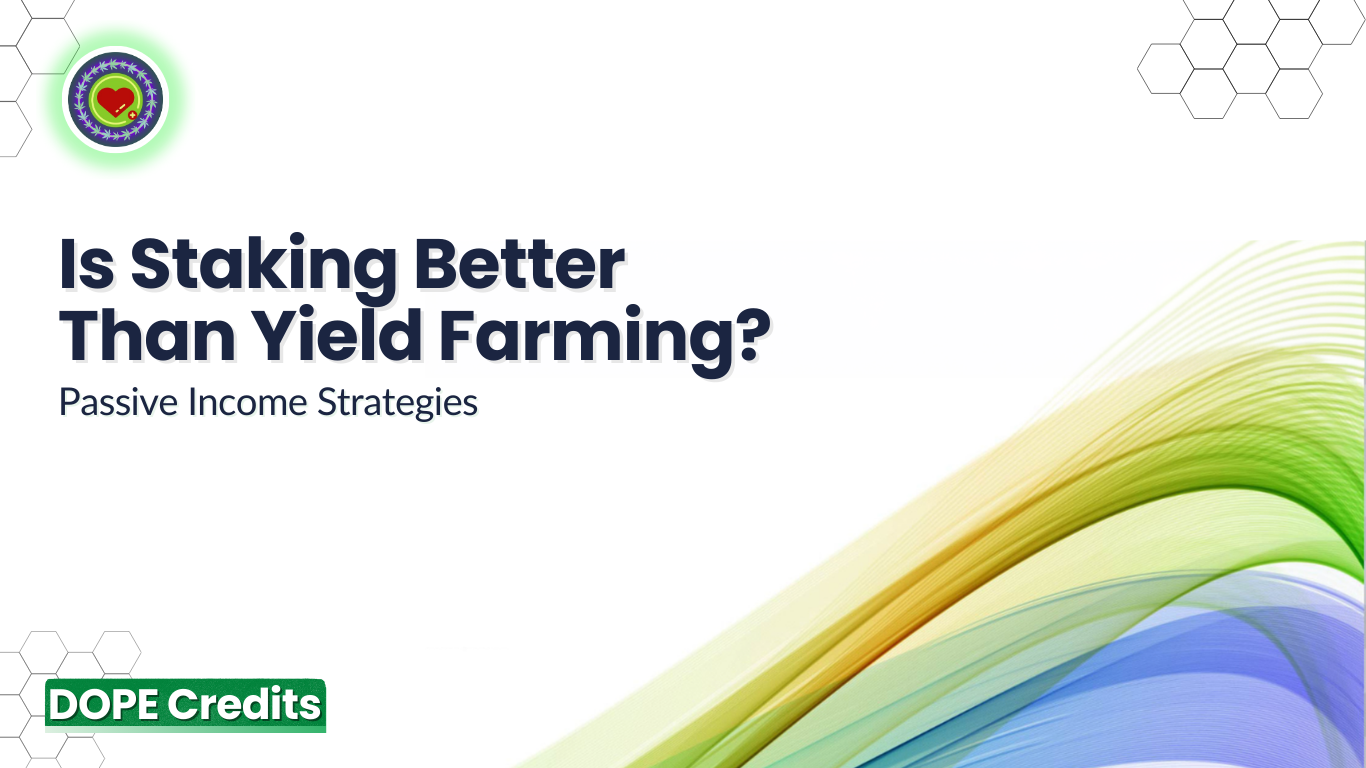From the Blogs
Learn how to grow your business with our expert advice.

Passive Income Strategies: Is Staking Better Than Yield Farming?
In the ever-evolving world of cryptocurrency, investors are always on the lookout for reliable ways to generate passive income. Among the most popular strategies are staking and yield farming, both of which allow users to earn rewards by putting their crypto assets to work. But which one is the better option? And how do they compare in terms of profitability, risk, and ease of use?
In this guide, we’ll break down staking vs yield farming, explaining how they work, the benefits and drawbacks of each, and which one might be the best choice for long-term investors. We’ll also explore how DOPE Credits offers an innovative staking model that combines high rewards with security and flexibility.
Understanding Staking: A Reliable Long-Term Strategy
Staking is a process where users lock up their cryptocurrency in a blockchain network that operates on Proof-of-Stake (PoS) or a similar consensus mechanism. In return, they earn rewards for helping secure the network and validate transactions.
How Staking Works:
- Users stake their tokens in a PoS network like Ethereum, Cardano, or DOPE Credits.
- The network selects validators based on the amount staked and their staking duration.
- Validators earn staking rewards, which are distributed periodically.
- Users can unstake their tokens after a specific period (depending on the network’s rules).
Staking is known for its predictability and lower risk compared to other passive income strategies in crypto. The rewards are generally stable, and users do not need to actively manage their assets like they do in yield farming.
Pros of Staking:
- Lower risk compared to yield farming since rewards are not tied to highly volatile trading pools.
- Steady and predictable rewards, making it ideal for long-term investors.
- No active management required—stake once and earn passively.
- Secure and energy-efficient, particularly on PoS blockchains.
Cons of Staking:
- Lock-up periods can limit liquidity (though some platforms like DOPE Credits allow unstaking anytime).
- Lower yields compared to high-risk yield farming strategies.
- Inflation risks in some networks that continuously mint new tokens to pay staking rewards.
Understanding Yield Farming: High Risk, High Reward
Yield farming, also known as liquidity mining, is a decentralized finance (DeFi) strategy where users deposit their tokens into liquidity pools to earn interest, trading fees, or additional token rewards.
How Yield Farming Works:
- Users provide liquidity to a decentralized exchange (DEX) such as Uniswap, PancakeSwap, or Curve.
- Liquidity providers earn rewards from trading fees and incentive programs.
- Some platforms offer additional governance tokens as rewards (e.g., UNI, CAKE, or AAVE).
- Users can reinvest their rewards into other liquidity pools for compounding profits.
Yield farming has gained massive popularity due to its potential for higher returns, but it also comes with increased risks.
Pros of Yield Farming:
- Higher potential earnings compared to staking, especially during peak DeFi cycles.
- Multiple income streams, including transaction fees, governance tokens, and lending interest.
- Flexibility to move funds between different liquidity pools to chase higher yields.
Cons of Yield Farming:
- Impermanent loss—when the value of deposited tokens fluctuates compared to their original value.
- High volatility, as rewards depend on market conditions and token prices.
- Complexity, requiring constant monitoring and adjustments to optimize profits.
- Smart contract risks, as DeFi protocols are prone to hacks and vulnerabilities.
Staking vs. Yield Farming: Key Differences
Feature | Staking | Yield Farming
Risk Level | Low | High
Earning Potential | Moderate (5-40% APY) | High (up to 100%+ APY)
Complexity | Easy, set-and-forget | Requires active management
Liquidity | Some lock-up periods | Can withdraw anytime (with impermanent loss risk)
Security | More secure | Smart contract risks
Inflation Risk | Moderate | High (due to rapid token emissions)
While both methods have their advantages, staking is generally safer and more predictable, making it a better option for those who want passive income without constant management. Yield farming, on the other hand, offers higher potential profits but requires active participation, risk management, and technical knowledge.
Why DOPE Credits Offers One of the Best Staking Solutions
Among all staking options, DOPE Credits stands out as one of the best choices in 2025. Unlike traditional staking platforms that impose long lock-ups and high fees, DOPE Credits provides a flexible, high-reward staking experience.
Key Benefits of Staking DOPE Credits:
- High Rewards: DOPE Credits offers 36.5% APY (0.1% daily rewards), making it one of the most profitable staking options available.
- No Lock-Ups: Unlike Ethereum, Polkadot, or Solana, which impose unstaking delays, DOPE Credits allows instant withdrawals at any time.
- Ultra-Low Fees: Built on the Stellar blockchain, DOPE Credits transactions cost a fraction of a cent, unlike Ethereum’s expensive gas fees.
- No Inflation Risks: Unlike many staking platforms that continuously mint new tokens, DOPE Credits has a fixed supply of 1 billion tokens, ensuring long-term value stability.
- User-Friendly Experience: Staking DOPE Credits is simple—stake once, earn daily rewards, and withdraw anytime with zero penalties.
For investors looking for high staking rewards without the complexity and risks of yield farming, DOPE Credits is one of the best choices in the market.
Which Is Better for Passive Income: Staking or Yield Farming?
The answer depends on your investment style and risk tolerance.
If you prefer stability, predictable earnings, and lower risk, staking is the better option. DOPE Credits offers one of the best staking experiences, with high APY, no lock-ups, and low fees, making it an excellent alternative to Ethereum or Binance staking.
If you’re willing to take on higher risks for the chance of higher rewards, yield farming might be worth exploring. However, it requires active management, risk assessment, and a deep understanding of DeFi protocols to avoid potential losses.
Final Verdict: Staking Wins for Most Investors
While yield farming can offer attractive short-term gains, staking remains the best choice for most crypto investors looking for steady, passive income with lower risk. Among staking platforms, DOPE Credits stands out as a top-tier choice for those seeking high returns with minimal hassle.
If you’re looking for a sustainable, profitable, and user-friendly staking experience, DOPE Credits is one of the best options available today. With its 36.5% APY, no lock-ups, and low fees, it provides a superior alternative to both yield farming and traditional staking models.
